Reflection of Light
Maharashtra Board-Class 9-Science & Technology-Chapter-11
Solution
Question 1:
Answer the following questions.
1. Explain the difference between a plane mirror, a concave mirror and a convex mirror with respect to the type and size of the images produced.
Mirror
Type of image
Size of image
Plane mirror
Virtual and erect
Same size as that of object
Concave mirror
Real and inverted as well as virtual and erect depending on the position of object w.r.t. the mirror
Smaller than the object or larger than the object or of the same size of that object.
Convex mirror
Always virtual and erect
Smaller than the object
2. Describe the positions of the source of light with respect to a concave mirror in
i. Torch light, ii. Projector lamp, iii. Flood light
i.Torch light: In a torch light, the source of light is placed at the focus of the concave mirror to obtain a parallel beam of light.
ii. Projector lamp: In a projector lamp, the source of light is placed at the centre of curvature of the concave mirror.
iii. Flood light: Here the source of light is placed just beyond the centre of curvature of the concave mirror.
3. Why are concave mirrors used in solar devices?
Concave mirror is also known as converging mirror because of its ability of focus the parallel rays at a single point anywhere on its focal plane.
4. Why are the mirrors fitted on the outside of cars convex?
5. Why does obtaining the image of the sun on a paper with the help of a concave mirror burn the paper?
6. If a spherical mirror breaks, what type of mirrors are the individual pieces?
When spherical mirror breaks, their nature does not change because there is no change in the nature of the reflecting surface and radius of the curvature. This means if a concave mirror breaks into pieces, the pieces will act as concave mirrors only. Same happens in case of convex mirrors.
Question 2:
What sign conventions are used for reflection from a spherical mirror?
Sign Conventions for spherical Mirrors: According to the Cartesian sign convention, the pole of a spherical mirror is taken as the origin and principal axis is taken as the X-axis of the frame of references. (1) Objects are always placed to the left of the mirror i.e. light must fall on the mirror from left to right. (2) All distances are measured from the pole of the mirror. (3) Distances along the direction of the incident ray (along positive x- axis) are taken as positive, while distances along the direction of the reflected ray (along negative x-axis) are taken as negative. (4) Heights measured perpendicular to and above the principal axis (along positive y-axis) are taken as positive. (5) Heights measured perpendicular to and below the principal axis (along negative y-axis) are taken as negative. These sign conventions can also represented in the following diagram
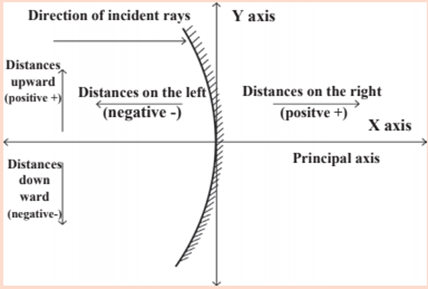
Question 3:
Draw ray diagrams for the cases of images obtained in concave mirrors as described in the table on page 122.
(I) Object between the focus (F) and the pole (P) In this case, the image is formed behind the mirror. This image is virtual, erect and magnified. (II) Object is at the focus (F) In this case, the image is formed at infinity. This image is real, inverted and highly enlarged. (III) Object between the centre of curvature (C) and focus (F) In this case, the image is formed behind the centre of curvature. This image is real, inverted and magnified. (IV) Object is at the centre of curvature In this case, the image is formed at the centre of curvature. This image is real, inverted and of the same size as the object. (V) Object is beyond the centre of curvature In this case, the image is formed between the focus (F) and the centre of curvature (C). This image is real, inverted and diminished. (VI) Object is at infinity The light rays coming from infinity are parallel. When parallel light rays are incident on the reflecting surface of a concave mirror, they tend to meet at its focus after reflection. In this case, the image is formed at the focus, and is point-sized. It is real, inverted and highly diminished.

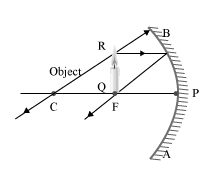
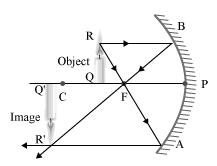
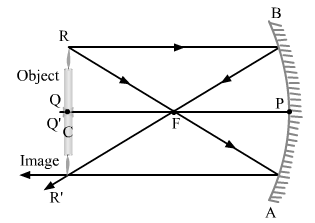

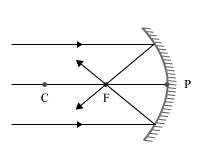
Question 5:
Solve the following examples
1. An object of height 7 cm is kept at a distance of 25 cm in front of a concave mirror. The focal length of the mirror is 15 cm. At what distance from the mirror should a screen be kept so as to get a clear image? What will be the size and nature of the image?
Given, Concave mirror h2=? (i) As the image to be obtained on a screen, it must be real image Now, using mirror formula, we have 1/f = (1/v)+(1/u) ∴ 1/v =(1/f)-(1/u)=(1/-15)-(1/-25) = -2/75 = -37.5 cm ∴ h2 = -h1(v/u) ∴ h2 = -7(-37.5/-25)= -7x1.5= -10.5cm The size (height) of the image = -10.5 cm Minus sign shows image is inverted
h1 = 7 cm
u = −25 cm
f = −15 cm
v=?
The screen should be placed at a distance of 37.5 cm in front of the concave mirror.
Now, using magnification formula, we have
h2/h1= -(v/u)
2. A convex mirror has a focal length of 18 cm. The image of an object kept in front of the mirror is half the height of the object. What is the distance of the object from the mirror?
Given : Convex mirror, f = 18 cm M= h2/h1 = -(v/u) =1/2 (1/v) + (1/u) = 1/f ∴ (1/-(u/2)) + (1/u) = 1/f …. from eq (i) ∴ (1/u)(1-2) = 1/f ∴ -(1/u) = 1/f ∴ u = -f =-18cm
h2 = h1/2
∴ v= -(u/2) …… (i)
Hence, the object is kept at 18cm in front of the mirror
3. A 10 cm long stick is kept in front of a concave mirror having focal length of 10 cm in such a way that the end of the stick closest to the pole is at a distance of 20 cm. What will be the length of the image?
Given: Concave mirror, h1= 10cm, f = -10cm, u = -20cm, h2 = ? (1/v) + (1/u) = 1/f ∴ 1/v = (1/f)-(1/u) ∴ u/v = (u/f)-1 = (-20/-10)-1 = 2-1 = 1 ∴ u/v = 1 M = h2/h1 = -(u/v) ∴ h2 = -(u/v) x h1 = -1xh1 = -1x10 = -10cm Therefore, the length of the image = 10 cm (….minus sign not considered)
Question 6:
Three mirrors are created from a single sphere. Which of the following - pole, centre of curvature, radius of curvature, principal axis - will be common to them and which will not be common?

Let us name the mirrors as M1, M2 and M3 as shown below. From the figure, we see that Why the pole and the principal axis cannot be common can be seen from the definitions/figure of these terms

Useful links :
| Main Page : - Maharashtra Board Class 9th Science & Technology - All chapters notes, solutions, videos, test, pdf.
Previous Chapter : Chapter 10: Information Communication Technology - online Solution Next Chapter : Chapter 12: Study of Sound - online Solution |